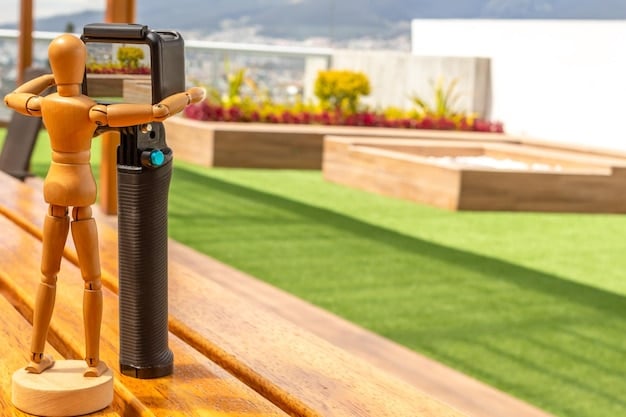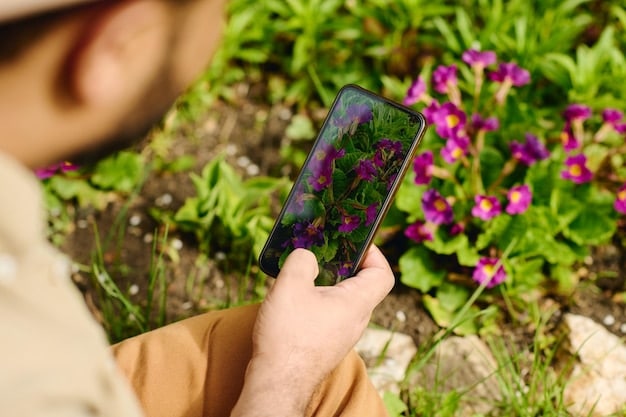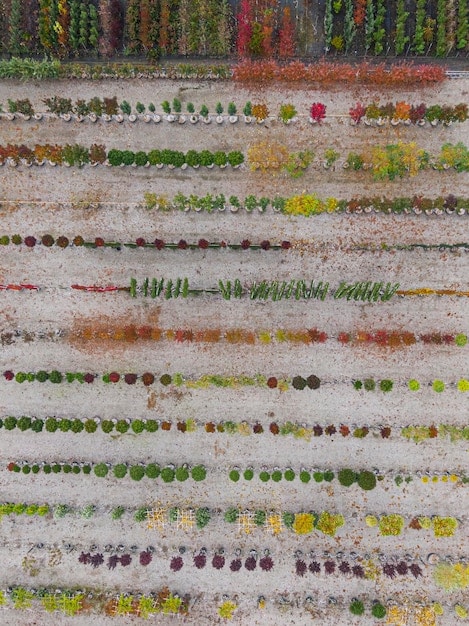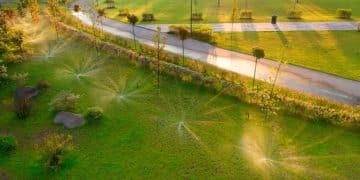Smart Garden Technology: Monitoring Soil & Weather in US Backyards

Anúncios
Smart garden technology revolutionizes backyard gardening by providing precise, real-time monitoring of soil and weather conditions, empowering US gardeners with data-driven insights for optimal plant health and resource efficiency.
In the evolving landscape of home gardening, the traditional approach is rapidly giving way to innovative solutions. The integration of smart garden technology: monitoring soil and weather conditions in US backyards is no longer a futuristic concept but a tangible reality, transforming how enthusiasts care for their plants.
The Rise of Smart Garden Technology: A New Era for Home Growers
In recent years, the intersection of technology and horticulture has blossomed, leading to an impressive array of smart garden solutions. These innovations are not just novelties; they address fundamental challenges faced by gardeners, from amateur enthusiasts to seasoned pros. The core promise of smart garden technology lies in its ability to provide precise, real-time data, enabling more informed and efficient gardening practices. It moves beyond guesswork, offering actionable insights that can significantly impact plant health, yield, and resource conservation.
Addressing the Garden’s Hidden Needs
Traditional gardening often involves a degree of trial and error, particularly when it comes to understanding the invisible world beneath the soil and the subtle shifts in local weather. A plant’s health is intrinsically linked to these environmental factors, and an imbalance can lead to stunted growth, disease, or even death. Smart garden technology steps in to demystify these variables.
- Soil Moisture Sensors: These devices accurately measure the water content in the soil, preventing both over and under-watering, which are common killers of garden plants.
- Nutrient Monitors: Going beyond basic moisture, some advanced sensors can detect essential nutrient levels, signaling when your plants need a boost.
- pH Level Trackers: Soil pH significantly impacts nutrient availability; smart sensors can alert gardeners to imbalances that might be hindering plant growth.
Beyond the Soil: Understanding Weather’s Impact
While soil conditions are crucial, external factors like weather play an equally significant role. Temperature extremes, sudden rainfall, humidity, and sunlight intensity all influence a plant’s ability to thrive. Smart garden technology extends its reach to monitor these atmospheric conditions, often with hyperlocal accuracy.
- Temperature and Humidity Sensors: These provide crucial data for protecting sensitive plants from frost or excessive heat and humidity.
- Rainfall Gauges: Integrated smart gauges can track precipitation, helping rationalize irrigation schedules and prevent overwatering from natural sources.
- Light Sensors: Determining the precise amount of sunlight a specific area of your garden receives throughout the day helps in plant selection and placement.
The adoption of these technologies marks a significant shift, transforming passive backyard cultivation into an active, data-driven science. Gardeners are no longer just nurturing plants; they are managing ecosystems with unparalleled precision, all from the convenience of their smartphones or connected devices. This technological leap allows for proactive intervention, fostering healthier plants and more bountiful harvests while minimizing waste. It represents a paradigm shift from reactive problem-solving to preventive care, putting the power of analytical gardening directly into the hands of the home grower.
Precision Planting: How Soil Sensors Are Redefining Gardening
The foundation of a thriving garden lies beneath the surface, in the soil. For generations, understanding soil composition, moisture, and nutrient levels was a matter of intuition, experience, or rudimentary testing. Today, soil sensors have transformed this process, offering an unprecedented level of precision that empowers even novice gardeners to cultivate like experts. These intelligent devices provide insights that were once only accessible to commercial agricultural operations, making data-driven decisions a reality for every backyard.
Soil sensors come in various forms, each designed to measure specific parameters vital for plant growth. Their consistent, real-time reporting eliminates much of the guesswork, allowing gardeners to respond proactively to their plants’ individual needs rather than reacting to visible signs of stress. This proactive approach is key to nurturing a healthy and resilient garden.
Understanding Soil Moisture Dynamics
One of the most critical factors for plant health is proper watering. Both overwatering and underwatering can be detrimental, leading to root rot, nutrient deficiency, or desiccation. Soil moisture sensors provide the data needed to strike the perfect balance.
- Capacitive Sensors: These measure the dielectric permittivity of the soil, which correlates with its water content. They are generally more accurate and less prone to corrosion than resistive sensors.
- Resistive Sensors: While simpler and often less expensive, these sensors measure electrical resistance between two probes, which changes as soil moisture varies. Their longevity can be limited by corrosion.
- Tensiómetros: These devices measure the tension with which water is held in the soil, giving an indication of how much effort a plant needs to extract water.
By continuously monitoring soil moisture, these sensors can trigger alerts when plants need water, or even automate irrigation systems to deliver water precisely when and where it’s needed. This not only promotes healthier plants but also conserves water, a crucial benefit in regions facing drought or water restrictions.
Nutrient and pH Monitoring for Optimal Growth
Beyond water, plants require a specific balance of nutrients and an appropriate pH level to absorb those nutrients effectively. Previously, gardeners relied on soil testing kits providing infrequent snapshots of soil health. Modern sensors offer continuous monitoring.
Soil pH directly impacts nutrient availability; different plants thrive in different pH ranges. For example, blueberries prefer acidic soil, while lavender prefers alkaline. Maintaining the correct pH is essential for nutrient uptake. Similarly, tracking macro and micronutrients allows gardeners to apply fertilizers only when necessary, preventing over-fertilization which can harm plants and pollute groundwater. This targeted approach ensures plants receive exactly what they need, minimizing waste and maximizing nutrient absorption for robust growth. The precision these sensors offer translates directly into stronger, healthier plants and more abundant yields.
Weathering the Storm: How Backyard Weather Stations Are Boosting Resilience
While soil conditions provide the foundation for plant health, local weather patterns dictate the daily battle. Temperature fluctuations, sudden downpours, unexpected frosts, and intense solar radiation can turn a promising garden into a struggling one overnight. Traditional weather forecasts offer regional data, but they often lack the hyperlocal specificity crucial for backyard gardening. This is where personal weather stations integrated into smart garden systems become invaluable, providing real-time, microclimatic data that significantly boosts garden resilience.
These compact, sophisticated devices monitor a suite of meteorological parameters directly from your backyard, offering an unparalleled understanding of the immediate environment your plants inhabit. This data allows for proactive adjustments and protective measures, turning potential disasters into minor inconveniences.
Real-time Environmental Intelligence
Smart weather stations capture detailed information that goes far beyond a general forecast. They become your personal meteorological assistant, providing immediate insights into conditions specific to your garden’s unique microclimate. This level of detail is critical for making timely decisions.
- Temperature and Humidity: Monitoring ground-level and ambient temperatures helps safeguard sensitive plants from frost damage or heat stress. Humidity tracking is crucial for preventing fungal diseases or ensuring optimal conditions for certain plant types.
- Wind Speed and Direction: Strong winds can cause physical damage to plants and dry out soil rapidly. Knowing wind patterns helps in planning protective barriers or choosing appropriate plant varieties.
- Rainfall Accumulation: Precise rainfall data allows for adjustments to irrigation schedules, preventing overwatering and conserving municipal water resources. This is especially important in regions with unpredictable summer showers.
By integrating this real-time data with soil sensor information, gardeners gain a holistic view of their garden’s ecosystem. For instance, a sudden temperature drop accompanied by high humidity might signal a risk of blight, prompting early preventive measures.
Proactive Strategies for Climate Challenges
The true power of a smart weather station lies in its ability to enable proactive rather than reactive gardening. Instead of discovering damaged plants after a weather event, you can often mitigate the impact beforehand. For example, receiving an alert about an impending frost allows time to deploy protective covers for tender plants.
Similarly, in periods of intense heat, monitoring solar radiation and ground temperature enables gardeners to schedule watering during cooler parts of the day or install shade cloths proactively. This predictive capability translates directly into healthier, more resilient plants that are better equipped to withstand environmental stresses. It means fewer losses due to unexpected weather events and a more consistent, bountiful harvest year-round.
The Connectivity Advantage: IoT Integration in Your Backyard
The true intelligence behind smart garden technology isn’t just about individual sensors; it’s about their seamless integration into a larger ecosystem powered by the Internet of Things (IoT). IoT connects devices, allowing them to communicate and share data, transforming disparate gadgets into a coordinated network. In the context of backyard gardening, this connectivity advantage means constant, centralized monitoring and often, automated responses, all accessible from anywhere.
The core of IoT integration in smart gardens involves sensors communicating with a central hub or directly with a cloud-based platform. This flow of data enables a comprehensive overview of your garden’s health and environmental conditions, empowering gardeners with informed decision-making tools.
Seamless Data Flow and Centralized Control
At its simplest, IoT integration means your soil moisture sensor talks to your smart irrigation system, or your weather station informs your plant care app. This eliminates manual checks and allows for dynamic adjustments based on real-time data.
- Cloud Platforms: Data from various sensors (soil, weather, light) is uploaded to a secure cloud platform, where it is analyzed and presented through user-friendly dashboards.
- Mobile Applications: Most smart garden systems come with dedicated mobile apps for iOS and Android, allowing gardeners to monitor conditions, receive alerts, and control devices remotely.
- Automated Actions: Based on predefined rules and live data, the system can automatically trigger actions, such as turning on sprinklers when soil moisture drops below a certain threshold or activating protective covers if frost is detected.
This centralized control means you no longer need to be physically present in your garden to understand its needs. From your office, on vacation, or even from another room in your house, you have full visibility and control over your garden’s environment.
Beyond Monitoring: Predictive Analytics and AI
The future of IoT in smart gardening extends beyond simple monitoring and automation. Leveraging artificial intelligence (AI) and machine learning (ML), these systems are becoming increasingly capable of predictive analytics.
For instance, an AI-powered system can learn your garden’s specific watering needs based on historical data, weather forecasts, and plant types, then predict optimal watering schedules to minimize water waste and maximize plant health. Some advanced systems can even detect early signs of plant disease or pest infestation by analyzing subtle changes in environmental data, prompting timely interventions. This shift from reactive problem-solving to proactive, predictive gardening is arguably the most transformative aspect of IoT integration in the backyard. It represents a significant leap towards truly intelligent and self-optimizing garden management.
Benefits for US Backyards: Sustainability and Savings
The adoption of smart garden technology in US backyards offers compelling advantages that extend far beyond simply growing healthier plants. It taps into critical contemporary concerns around sustainability and personal economics, providing tangible benefits through optimized resource use and reduced waste. For the average US homeowner, these technologies translate directly into water savings, lower energy bills, and a diminished environmental footprint, all while nurturing thriving green spaces.
The appeal of smart garden systems is multi-faceted, aligning with a growing public consciousness about environmental stewardship and the desire for more efficient home management. These systems don’t just make gardening easier; they make it smarter and more responsible.
Water Conservation: A Critical Advantage
In many parts of the US, water scarcity and drought conditions are persistent challenges. Over-watering not only wastes a precious resource but also leads to higher utility bills and can harm plants. Smart irrigation systems, informed by precise soil moisture and weather data, offer a powerful solution.
- Targeted Watering: Instead of fixed schedules, smart systems deliver water only when and where it’s needed, often adjusting for rain, evaporation rates, and plant-specific requirements.
- Leak Detection: Some advanced systems can even detect leaks in irrigation lines, preventing significant water loss and property damage.
- Evapotranspiration (ET) Data: By calculating ET rates (water lost from soil and plants to the atmosphere), smart systems can precisely replenish the water consumed, minimizing excess.
This intelligent approach to watering can lead to significant reductions in water consumption – often 30% or more – directly translating to lower water bills for homeowners. It’s a win-win: healthier plants and a lighter financial and environmental burden.
Energy Efficiency and Reduced Resource Use
Beyond water, smart garden technology contributes to overall resource efficiency. Automated lighting systems, for example, can ensure plants receive optimal light without unnecessary energy expenditure. Nutrient monitoring prevents the overuse of fertilizers, which not only saves money but also reduces runoff into local waterways, protecting delicate ecosystems.
By minimizing waste and maximizing efficiency, smart garden technology makes backyard gardening a more sustainable activity. It empowers homeowners to be more environmentally conscious, transforming their gardens into models of eco-friendly practices. This holistic approach to resource management underscores the profound positive impact these technologies are having on individual backyards and the broader environmental landscape across the US.
Choosing the Right Smart Garden System for Your Home
Navigating the burgeoning market of smart garden technology can feel overwhelming, given the array of sensors, hubs, and platforms available. Selecting the right system for your US backyard depends on several factors, including your gardening goals, the size and complexity of your garden, your budget, and your comfort level with technology. A well-chosen system should integrate seamlessly into your lifestyle, providing valuable insights without creating unnecessary complexity.
It’s crucial to assess your specific needs before making a purchase. Do you primarily need help with watering? Are you interested in detailed nutrient analysis? Or do you require comprehensive weather monitoring? Understanding your priorities will narrow down the options considerably.
Factors to Consider When Buying
The diversity in smart garden products means there’s likely a solution for every gardener, but careful consideration is key to a satisfactory investment.
- Compatibility and Ecosystem: Some systems are proprietary, while others work with a broader range of third-party sensors and smart home platforms (like Google Home or Amazon Alexa). Consider future expandability and integration with existing smart devices.
- Ease of Installation and Use: Look for systems with intuitive setup processes and user-friendly mobile applications. Not everyone is tech-savvy, and a complex system can quickly become a dormant investment.
- Sensor Accuracy and Durability: Research reviews for sensor reliability and longevity. Outdoor environments are harsh, and devices need to withstand varying weather conditions.
- Battery Life/Power Source: Assess how often sensors need battery replacement or if they are solar-powered. Constant battery changes can be a nuisance.
Matching Technology to Your Gardening Style
Your gardening objectives should guide your choice. For a beginner focused on basic care, a simple soil moisture sensor with an accompanying app might suffice. For advanced gardeners growing speciality crops, a comprehensive system with nutrient, pH, and hyperlocal weather monitoring would be more appropriate.
For small container gardens or indoor plants, compact, all-in-one smart planters can provide encapsulated solutions. For expansive landscapes, modular systems that allow for multiple sensors across different garden zones are more practical. The goal is to find a system that enhances your gardening experience, not complicates it. By carefully weighing these considerations, US homeowners can select a smart garden technology solution that truly meets their needs, transforming their outdoor spaces into efficient, thriving havens.
The Future of Smart Gardens: Innovations on the Horizon
The rapid evolution of technology suggests that what we see in smart garden systems today is merely a foundation for what’s to come. The future promises even more integrated, intuitive, and autonomous solutions that will further blur the lines between traditional gardening and high-tech horticulture. Innovations are set to enhance every aspect of garden management, making sophisticated care accessible to an even broader audience in US backyards.
As artificial intelligence (AI), machine learning (ML), and robotics become more sophisticated and affordable, their integration into smart garden technology will likely lead to capabilities we can only vaguely imagine today. This convergence of technologies aims to optimize plant growth with unprecedented precision while reducing human effort.
AI-Powered Diagnostics and Personalized Care
One of the most exciting frontiers is the advancement of AI and ML to provide highly personalized plant care. Current systems offer data; future systems will offer prescriptive solutions.
- Predictive Analytics: AI will analyze vast datasets, including local weather patterns, historical plant growth, and current sensor readings, to predict potential issues before they manifest. It could forecast disease outbreaks based on humidity trends or nutrient deficiencies based on plant growth rates.
- Automated Diagnostics: Imagine a system that can identify a specific plant pest or disease from an image captured by a garden camera and then recommend the exact treatment, whether organic or chemical.
- Hyper-Personalized Nutrient Delivery: Advanced systems could micro-dose specific nutrients to individual plants based on their real-time uptake and growth stage, optimizing health and yield like never before.
This level of intelligence will turn smart gardens into proactive ecosystems that largely manage themselves, alerting the gardener only when human intervention is truly necessary or when a major harvest is ready.
Robotics and Advanced Automation
Beyond static sensors, the advent of affordable robotics is set to revolutionize physical garden tasks. While nascent, the concept of robotic assistants in the garden is gaining traction.
Small, autonomous garden robots could perform repetitive tasks such as precise weeding, targeted watering, or even harvesting ripened produce. Imagine a robot that patrols your garden, removes weeds identified by AI, and then sends you a notification when your tomatoes are perfectly ripe for picking. These robots could work in conjunction with existing sensor networks, responding to real-time data to optimize their activities. This profound integration of AI, ML, and robotics points towards a future where smart gardens are not just monitored and automated, but are truly intelligent, adaptive, and largely self-sustaining. This vision positions backyard gardening at the forefront of sustainable and technologically advanced living.

| Key Aspect | Brief Description |
|---|---|
| 💧 Soil Moisture | Sensors prevent over/under-watering, saving water and promoting root health. |
| ☀️ Weather Monitoring | Backyard stations provide hyperlocal data for proactive plant protection. |
| 🔗 IoT Integration | Connects devices for centralized control and automated, data-driven actions. |
| 💰 Sustainability & Savings | Reduces water, fertilizer, and energy use, lowering costs and environmental impact. |
Frequently Asked Questions About Smart Garden Technology
Smart garden technology refers to the use of sensors, IoT devices, and sometimes AI to monitor and optimize plant growth conditions. This includes tracking soil moisture, nutrient levels, pH, and local weather conditions to provide gardeners with real-time data and actionable insights, often accessible via smartphone apps.
Soil sensors measure critical parameters like moisture content, temperature, and sometimes nutrient or pH levels. This data helps gardeners avoid common pitfalls like overwatering or underwatering, ensures plants receive adequate nutrients, and helps maintain optimal soil conditions for specific plant types, leading to healthier growth.
Yes, significantly. By precisely monitoring needs, smart systems can optimize irrigation schedules, leading to substantial water savings and lower utility bills. They also help prevent the overuse of costly fertilizers and other resources, reducing waste and contributing to a more sustainable and economically efficient gardening practice over time.
Backyard weather stations provide hyperlocal accuracy, meaning they monitor conditions specifically in your garden, which can vary significantly from broader regional forecasts. This precise data on temperature, humidity, rainfall, and wind helps you make informed decisions for proactive plant protection against localized weather events like frost or intense heat.
While some advanced systems can be complex, many smart garden technologies are designed for ease of use, with straightforward installation and intuitive smartphone apps. Manufacturers prioritize user-friendliness, making these tools accessible for gardeners of all skill levels, from beginners to seasoned enthusiasts, with clear guidance for setup and daily operation.

Conclusion
The integration of smart garden technology into US backyards represents a pivotal shift in how we approach horticulture. Moving beyond traditional methods, these innovative systems offer unprecedented precision in monitoring crucial environmental factors like soil conditions and localized weather patterns. This data-driven approach not only fosters healthier, more resilient plants but also champions sustainability by optimizing resource use and minimizing waste. As these technologies continue to evolve, they promise to make gardening more efficient, enjoyable, and environmentally conscious for every home grower, transforming backyards into thriving, intelligent ecosystems.





